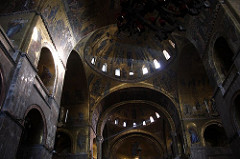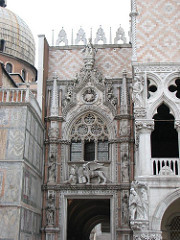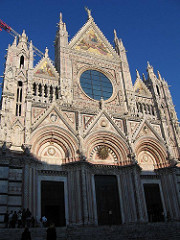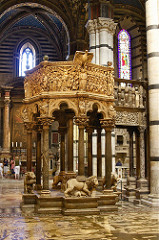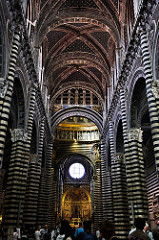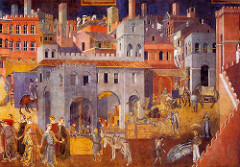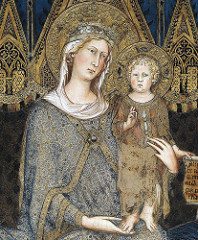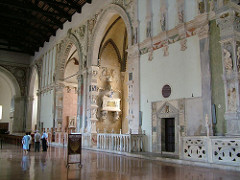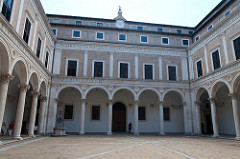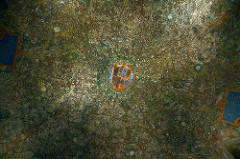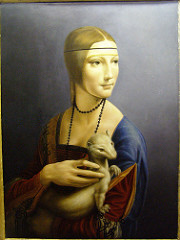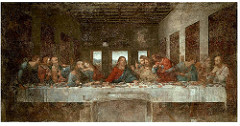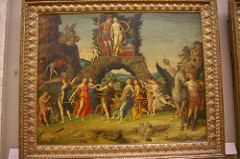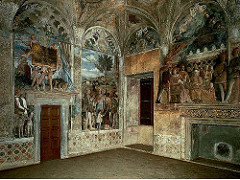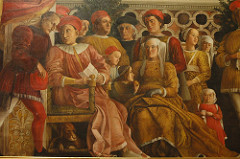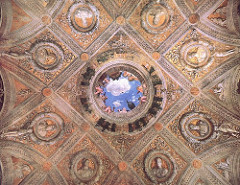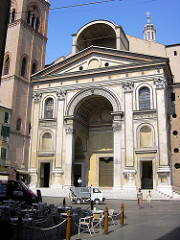St. Mark’s Basilica, Venice, rebuilt 1060
greek cross ground plan influenced by church of apostles in constantinople, modeled on byzantine prototype, late gothic decoration, marble gives visual expression to success/wealth, scene of transferring Mark’s body here, bronze horses brought from constantinople as booty after 4th crusade, porphyry tetrarchs
S. Marco interior, Venice
5 domes supported by round arches rested on piers, compare with hagia sophia, marble floor opus sectile design
Pala d’Oro altarpiece, S Marco
gold, gem studded, byzantine craftsmanship, gothic statue altarscreen
Doge’s Palace, Venice, 1340-late 1400s
gothic style emphasizes link with n europe through commerce, less masculine than on in florence giving effect of society being serene and welcoming
Porta della Carta, entrance to Doge’s Palace
byzantine, doge kneeling in front of st mark winged lion
The Cathedral, Siena, Giovanni Pisano, 1299
visual expression to beliefs, civic pride, political identity, black and white stone of siena sets apart from rest of city, extremely gothic, french influence, projecting statues, competition with florence prompts expansion
Siena Cathedral Pulpit, Nicola Pisano, 1268
similar to his in pisa but more accommodating of siena demands, less classicizing more gothic
Maesta, Agostinio di Duccio, 1311, siena cathedral altarpiece
earth shattering, double sided, virgin is the protector centrally enthroned, rich decoration, elongated to show importance, 4 surrounding alters devoted to her
Siena Cathedral interior
depictions of the virgin, see selves as citizens of republic devoted to her, political agenda
The Palazzo Pubblico, 1310
built for common good, public spirited nature shows benign mother state looking after children, fountain for public use, prominent bell tower summoned council and announced time to the citizens
Allegory of Good Government/The Good City, Ambrogio Lorenzetti, 1338, Sala del Nove, palazzo pubblico
common good attended by civic and theological virtues, citizens connect justice to the common good, justice unifies while ben commune governs by following virtues; impact of this government is smooth functioning and happiness when justice rules
Maesta, Simone Martini, 1315, sala del consiglio, palazzo pubblico
not as grand as duccio’s but still patriotic, not to promote a citizen but ennoble virgin in thanks, speaks to democrats making sure they make honest laws and not overpower the weak
Tempio Malatestiano, LB Alberti, 1450, Rimini (incomplete)
commissioned by sigismondo to show his significance, white marble shows connection to rome, classicizing design incorporates antique roman forms of triumphal arch and the aqueduct, sarcophagi in side arches, imperial victory
Tempio Malatestiano interior, Duccio, chapel of st. sigismund/the ancestors/music-making angels, tomb of isotta degli atti
gold, lapis lazry, stone interior give sense of richness; painting of sigismondo and his saint display his worth endorsed by higher power
Palazzo Ducale, Francesco Laurana, Francesco Martini, 1468+, Urbino
commissioned by federigo montefeltro, reflection of his outlook, palace and city at one, harmony in materials, proportion, inviting doors of public, good design can elevate society
Palazzo Ducale courtyard, Urbino
open and inviting, precise measurement, unlike fortress nature of Sigismondo’s castle that kept people out, interior dedicated to holy ghost, a wooded study with manuscripts and paintings of famous men
sforza castle, sala delle asse ceiling fresco, da vinci, 1498, milan
covered in trees suggesting viewer is outside, courtly language and metaphor used shows da vinci was more suited as court artist, this position contributed to growing status of the artist in society
portrait of cecilia gallerani, da vinci, 1490, milan
the favorite mistress of ludovico, she invited leo to intellectual meetings, holds an ermine a symbol of ludovico, emerges from darkness, evokes personality, unlike typical solemn portraits of women with sharp profile and no individuality, leo gives more than the usual here
the last supper, da vinci, 1498, refectory of santa maria delle grazie, milan
did not survive test of time, geometry used to show room extending into wall, spacious sense, opportunity to explore human response/gesture
castlenuovo, 1450s, naples
commissioned by alfonso, in tune with late architecture of aragon influenced by french, interior with spanish design and amazing vault system, gothic tendencies
Arch of Alfonso, 1466, white marble, triumphal monument/castle gate/cenotaph, naples, compare with arch of titus in rome
classicizing, immortalizes alfonso’s victorious entry into naples, shows his embodiment of cardinal virtues, wants to be honored so makes it seem like he is an emperor
samson and delilah
Mantegna, 1490, ferrara, for isabella d’este; manifestation of men, done in a single color to give sculptural effect, example of strong women
pallas expelling the vices, mantegna, 1499, ferrara
for isabella, call of women having to assert self against inferior views, tree=virtue deserted, 3 virtues in sky, prudence imprisoned, izzy rushing to garden
pernassus, mantegna, 1497, ferrara
place governed by apollo that promotes learning/art, dancing muses in center
garden of peaceful arts, allegory of the court of isabella d’este
lorenzo costa, 1504; isabella is thought to be the lady being crowned, protected by gods, sheltered from battle by music/art/literature/learning, gives sense of her ambition
Mantegna, camera degli sposi, castello s giorgio, palazzo ducale, mantua
transformed space with perspective, views of gonzaga court life, subtle self references in association with gonzaga show his intelligence and status
ludovico gonzaga and his court, mantegna, 1474, mantua
seated are most distinguished, court dressed in red and white tights, depicts moment when servant tells ludovico the good news of son’s arrival as cardinal
ceiling of camera degli sposi, mantegna, mantua
portrait of the first 8 roman emperors and reliefs of the deeds of classical heroes; virtual oculus shows genius and command of what the eye sees, in tune with illusionism we read in writings
s andrea basilica, LB Alberti, 1470s, mantua
large, spacious, barrel vaulted, inspired by roman basilica, contains mantegna’s chapel in association with gonzaga, thinking of his legacy, expression to his excellence, proclaims to be greater than greek world greatest painter, underlines development of artistic status which he achieves

